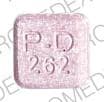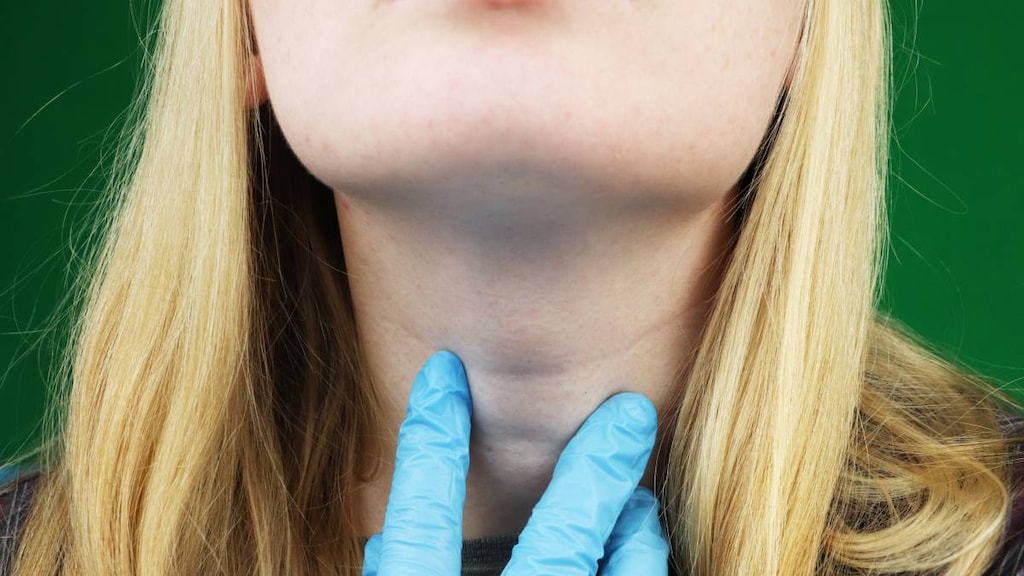Boxed Warning
Weight reduction:
Drugs with thyroid hormone activity, alone or with other therapeutic agents have been used for the treatment of obesity. In euthyroid patients, doses within the range of daily hormonal requirements are ineffective for weight reduction. Larger doses may produce serious or even life-threatening manifestations of toxicity, particularly when given in association with sympathomimetic amines such as those used for their anorectic effects.
Dosage Forms
Excipient information presented when available (limited, particularly for generics); consult specific product labeling.
Tablet, oral:
Thyrolar: 1/4 [levothyroxine sodium 12.5 mcg and liothyronine sodium 3.1 mcg]
Thyrolar: 1/2 [levothyroxine sodium 25 mcg and liothyronine sodium 6.25 mcg]
Thyrolar: 1 [levothyroxine sodium 50 mcg and liothyronine sodium 12.5 mcg]
Thyrolar: 2 [levothyroxine sodium 100 mcg and liothyronine sodium 25 mcg]
Thyrolar: 3 [levothyroxine sodium 150 mcg and liothyronine sodium 37.5 mcg]
Pharmacology
Mechanism of Action
The primary active compound is T3 (triiodothyronine), which may be converted from T4 (thyroxine) and then circulates throughout the body to influence growth and maturation of various tissues. Liotrix is uniform mixture of synthetic T4 and T3 in 4:1 ratio; exact mechanism of action is unknown; however, it is believed the thyroid hormone exerts its many metabolic effects through control of DNA transcription and protein synthesis; involved in normal metabolism, growth, and development; promotes gluconeogenesis, increases utilization and mobilization of glycogen stores and stimulates protein synthesis, increases basal metabolic rate
Pharmacokinetics/Pharmacodynamics
Absorption
Thyroxine (T4): 40% to 80%; T3: 95%
Metabolism
Hepatic to triiodothyronine (active); ~80% T4 deiodinated in kidney and periphery; glucuronidation/conjugation also occurs; undergoes enterohepatic recirculation
Excretion
Urine (major route of elimination); partially feces
Onset of Action
Liothyronine (T3): ~3 hours
Time to Peak
Serum: T4: 2-4 hours; T3: 2-3 days
Half-Life Elimination
T4: Euthyroid: 6-7 days; Hyperthyroid: 3-4 days; Hypothyroid: 9-10 days
T3: 2.5 days
Protein Binding
T4: >99% bound to plasma proteins including thyroxine-binding globulin, thyroxine-binding prealbumin, and albumin
Use: Labeled Indications
Hypothyroidism: Replacement or supplemental therapy in hypothyroidism
Note: Clinical practice guidelines currently do not recommend routine use of levothyroxine/liothyronine combinations over levothyroxine monotherapy in the management of hypothyroidism (Jonklaas 2014).
Contraindications
Hypersensitivity to liotrix or any component of the formulation; uncorrected adrenal insufficiency; untreated thyrotoxicosis
Dosage and Administration
Dosing: Adult
Hypothyroidism: Oral:
Initial: Levothyroxine 25 mcg/liothyronine 6.25 mcg once daily; a lower initial dose (levothyroxine 12.5 mcg/liothyronine 3.1 mcg) is recommended in patients with long-standing myxedema, especially if cardiovascular impairment coexists (if angina occurs, reduce dose). Dose may be increased in increments of levothyroxine 12.5 mcg/liothyronine 3.1 mcg every 2 to 3 weeks.
Usual maintenance dose: Levothyroxine 50 to 100 mcg/liothyronine 12.5 to 25 mcg once daily; inadequate response despite adequate dosage replacement may indicate nonadherence, poor absorption, excessive elimination, or inactivity of the preparation.
Dosing: Geriatric
Hypothyroidism: Oral: Initial: Levothyroxine 12.5 to 25 mcg/liothyronine 3.1 to 6.25 mcg once daily; may increase by levothyroxine 12.5 mcg/liothyronine 3.1 mcg every 2 to 3 weeks
Dosing: Pediatric
Note: Doses should be adjusted based on clinical response and laboratory parameters; guidelines do not recommend routine use of levothyroxine/liothyronine combinations over levothyroxine monotherapy in the management of hypothyroidism (AAP 2006; ATA [Jonklaas 2014]).
Congenital hypothyroidism: Note: Infants should have therapy initiated at full doses. Oral: Usual daily dosage range:
Infants ≤6 months: Liothyronine (T3): 3.1 to 6.25 mcg/levothyroxine (T4): 12.5 to 25 mcg once daily
Infants >6 to 12 months: Liothyronine (T3): 6.25 to 9.35 mcg/levothyroxine (T4): 25 to 37.5 mcg once daily
Children 1 to 5 years: Liothyronine (T3): 9.35 to 12.5 mcg/levothyroxine (T4): 37.5 to 50 mcg once daily
Children 6 to 12 years: Liothyronine (T3): 12.5 to 18.75 mcg/levothyroxine (T4): 50 to 75 mcg once daily
Adolescents: Typical doses > Liothyronine (T3): 18.75 mcg; levothyroxine (T4): 75 mcg once daily
Dietary Considerations
Take once a day on an empty stomach 30-60 minutes before meals.
Storage
Store at 2°C to 8°C (36°F to 46°F). Protect from light.
Liotrix Images
Drug Interactions
Amezinium: Thyroid Products may enhance the stimulatory effect of Amezinium. Monitor therapy
Amiodarone: May diminish the therapeutic effect of Thyroid Products. Monitor therapy
Apalutamide: May diminish the therapeutic effect of Thyroid Products. Monitor therapy
Bile Acid Sequestrants: May decrease the serum concentration of Thyroid Products. Management: Administer oral thyroid products at least 4 h prior to colesevelam, and at least 1 h before or 4-6 h after cholestyramine. Specific recommendations for colestipol are not available. Monitor for decreased concentrations/effects of the thyroid product. Consider therapy modification
Calcium Polystyrene Sulfonate: May decrease the serum concentration of Thyroid Products. Management: To minimize risk of interaction, separate dosing of oral calcium polystyrene sulfonate and thyroid products (eg, levothyroxine) or administer calcium polystyrene sulfonate rectally. Monitor for signs/symptoms of hypothyroidism with concomitant use (oral). Consider therapy modification
Calcium Salts: May diminish the therapeutic effect of Thyroid Products. Management: Separate the doses of the thyroid product and the oral calcium supplement by at least 4 hours. Consider therapy modification
CarBAMazepine: May decrease the serum concentration of Thyroid Products. Monitor therapy
Ciprofloxacin (Systemic): May decrease the serum concentration of Thyroid Products. Monitor therapy
Estrogen Derivatives: May diminish the therapeutic effect of Thyroid Products. Monitor therapy
Fosphenytoin: May decrease the serum concentration of Thyroid Products. Phenytoin may also displace thyroid hormones from protein binding sites. Monitor therapy
Lanthanum: May decrease the serum concentration of Thyroid Products. Management: Administer oral thyroid products at least two hours before or after lanthanum. Consider therapy modification
Phenytoin: May decrease the serum concentration of Thyroid Products. Phenytoin may also displace thyroid hormones from protein binding sites. Monitor therapy
Piracetam: May enhance the adverse/toxic effect of Thyroid Products. Specifically, symptoms including confusion, irritability, and sleep disorder have been described during concomitant use. Monitor therapy
RifAMPin: May decrease the serum concentration of Thyroid Products. Monitor therapy
Ritonavir: May diminish the therapeutic effect of Thyroid Products. Monitor therapy
Selective Serotonin Reuptake Inhibitors: May diminish the therapeutic effect of Thyroid Products. Thyroid product dose requirements may be increased. Monitor therapy
Sodium Iodide I131: Thyroid Products may diminish the therapeutic effect of Sodium Iodide I131. Avoid combination
Sodium Polystyrene Sulfonate: May decrease the serum concentration of Thyroid Products. Management: To minimize risk of interaction, separate dosing of oral sodium polystyrene sulfonate and thyroid products (e.g., levothyroxine) or administer sodium polystyrene sulfonate rectally. Monitor for signs/symptoms of hypothyroidism with concomitant use (oral). Consider therapy modification
Somatropin: May diminish the therapeutic effect of Thyroid Products. Monitor therapy
Theophylline Derivatives: Thyroid Products may increase the metabolism of Theophylline Derivatives. Exceptions: Dyphylline. Monitor therapy
Tricyclic Antidepressants: Thyroid Products may enhance the arrhythmogenic effect of Tricyclic Antidepressants. Thyroid Products may enhance the stimulatory effect of Tricyclic Antidepressants. Monitor therapy
Vitamin K Antagonists (eg, warfarin): Thyroid Products may enhance the anticoagulant effect of Vitamin K Antagonists. Monitor therapy
Test Interactions
T4-binding globulin (TBG): factors that alter binding in serum (ATA/AACE [Garber 2012]):
Note: T4 is ~99.97% protein bound. Factors that alter protein binding will affect serum total T4 levels; however, measurement of serum free T4 (the metabolically active moiety) has largely replaced serum total T4 for thyroid status assessment.
Conditions/states that increase TBG binding: Pregnancy, hepatitis, porphyria, neonatal state
Medications that increase TBG binding: Estrogens, 5-fluorouracil, heroin, methadone, mitotane, perphenazine, selective estrogen receptor modulators (eg, tamoxifen, raloxifene)
Conditions/states that decrease TBG binding: Hepatic failure, nephrosis, severe illness
Medications that decrease TBG binding: Androgens, anabolic steroids, glucocorticoids, L-asparaginase, nicotinic acid
Thyroxine (T4) and Triiodothyronine (T3): Serum binding inhibitors (ATA/AACE [Garber 2012]):
Medications that inhibit T4 and T3 binding: Carbamazepine, furosemide, free fatty acids, heparin, NSAIDS (variable, transient), phenytoin, salicylates
Thyroid gland hormone: Interference with production and secretion (ATA/AACE [Garber 2012]):
Medications affecting iodine uptake: Amiodarone, iodinated contrast agents, iodine, ethionamide
Medications affecting hormone production: Amiodarone, ethionamide, iodinated contrast agents, iodine, sulfonylureas, sulfonamides, thionamides (carbimazole, methimazole, propylthiouracil)
Medications affecting secretion: Amiodarone, iodinated contrast agents, iodine, lithium
Medications inducing thyroiditis: Alemtuzumab, amiodarone, antiangiogenic agents (lenalidomide, thalidomide), denileukin diftitoxin, interferon alpha, interleukins, lithium, tyrosine kinase inhibitors (sunitinib, sorafenib)
Medications potentially causing the development of Graves’: Alemtuzumab, interferon alpha, antiretroviral therapy
Medications potentially ameliorating thyroiditis (if autoimmune) or Graves’: Glucocorticoids
Hypothalamic-pituitary axis and TSH: Interference with secretion (ATA/AACE [Garber 2012]):
Medications decreasing TSH secretion: Bexarotene, dopamine, dopaminergic agonists (bromocriptine, cabergoline), glucocorticoids, interleukin-6, metformin, opiates, somatostatin analogues (octreotide, lanreotide), thyroid hormone analogues
Medications increasing TSH secretion: Amphetamine, interleukin 2, metoclopramide, ritonavir, St John's wort
Medications potentially causing hypophysitis: Ipilimumab
Adverse Reactions
Frequency not defined.
Cardiovascular: Cardiac arrhythmia, chest pain, increased blood pressure, palpitations, tachycardia
Central nervous system: Anxiety, ataxia, headache, insomnia, nervousness
Dermatologic: Alopecia, diaphoresis, pruritus, urticaria
Endocrine & metabolic: Menstrual disease, weight loss
Gastrointestinal: Abdominal cramps, constipation, diarrhea, increased appetite, nausea, vomiting
Neuromuscular & skeletal: Myalgia, tremor, tremor of hands
Respiratory: Dyspnea
Miscellaneous: Fever
<1%, postmarketing, and/or case reports: Allergic skin reaction
Warnings/Precautions
Disease-related concerns:
- Adrenal insufficiency: Use with caution in patients with adrenal insufficiency; symptoms may be exaggerated or aggravated; contraindicated in patients with uncorrected adrenal insufficiency. Treatment with glucocorticoids should precede thyroid replacement therapy in patients with adrenal insufficiency (ATA/AACE [Garber 2012]).
- Cardiovascular disease: Use with caution and initiate therapy at a lower dose in patients with angina pectoris or other cardiovascular disease; chronic hypothyroidism predisposes patients to coronary artery disease.
- Diabetes: Use with caution in patients with diabetes mellitus and insipidus; symptoms may be exaggerated or aggravated.
- Myxedema: Use with caution in patients with myxedema; symptoms may be exaggerated or aggravated; initial dosage reduction is recommended in patients with long-standing myxedema.
Special populations:
- Elderly: Use with caution in the elderly as these patients are more likely to have compromised cardiovascular function; lower initial dosage is recommended. Suppressed TSH levels may increase risk of atrial fibrillation and mortality secondary to cardiovascular disease (Gharib 2010; Parle 2001). Increase dose slowly and monitor for signs/symptoms of angina (ATA/AACE [Garber 2012]).
Other warnings/precautions:
- Infertility (unapproved use): Use is not justified for the treatment of male or female infertility in euthyroid patients.
- Weight reduction (unapproved use):[US Boxed Warning]: In euthyroid patients, thyroid supplements are ineffective and potentially toxic for weight reduction. High doses may produce serious or even life-threatening toxic effects, particularly when used with some anorectic drugs.
Monitoring Parameters
TSH 4 to 6 weeks after treatment initiation or dose changes, 4 to 6 months after adequate replacement dose determined, followed by every 12 months thereafter (or more frequently depending on clinical situation) (Jonklaas 2014); T4, heart rate, blood pressure, clinical signs of hypo- and hyperthyroidism; TSH is the most reliable guide for evaluating adequacy of thyroid replacement dosage in primary thyroid dysfunction. TSH may be elevated during the first few months of thyroid replacement despite patients being clinically euthyroid. In cases where T4 remains low and TSH is within normal limits, an evaluation of “free” (unbound) T4 is needed to evaluate further increase in dosage. Free T4 (not TSH) should be monitored to guide treatment in patients with central hypothyroidism (ATA/AACE [Garber 2012]).
Pregnancy
Pregnancy Considerations
Endogenous thyroid hormones minimally cross the placenta; the fetal thyroid becomes active around the end of the first trimester. Liotrix has not been found to increase the risk of adverse effects following maternal use during pregnancy.
Uncontrolled maternal hypothyroidism may result in adverse neonatal and maternal outcomes. To prevent adverse events, normal maternal thyroid function should be maintained prior to conception and throughout pregnancy. Levothyroxine is considered the treatment of choice for the control of hypothyroidism during pregnancy.
Patient Education
- Discuss specific use of drug and side effects with patient as it relates to treatment. (HCAHPS: During this hospital stay, were you given any medicine that you had not taken before? Before giving you any new medicine, how often did hospital staff tell you what the medicine was for? How often did hospital staff describe possible side effects in a way you could understand?)
- Patient may experience hair loss (children). Have patient report immediately to prescriber chest pain, fast heartbeat, abnormal heartbeat, headache, shortness of breath, irritability, anxiety, tremors, trouble sleeping, temperature sensitivity, sweating a lot, leg cramps, muscle weakness, abdominal cramps, lack of appetite, increased hunger, excessive weight gain or loss, swelling of arms or legs, lump on neck, diarrhea, vomiting, or menstrual changes (HCAHPS).
- Educate patient about signs of a significant reaction (eg, wheezing; chest tightness; fever; itching; bad cough; blue skin color; seizures; or swelling of face, lips, tongue, or throat). Note: This is not a comprehensive list of all side effects. Patient should consult prescriber for additional questions.
Intended Use and Disclaimer: Should not be printed and given to patients. This information is intended to serve as a concise initial reference for health care professionals to use when discussing medications with a patient. You must ultimately rely on your own discretion, experience, and judgment in diagnosing, treating, and advising patients.



